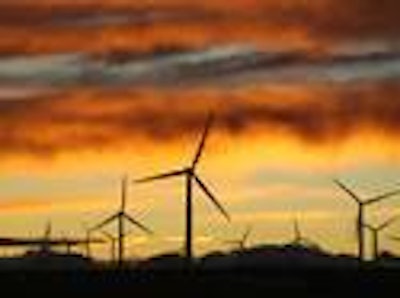

CHEYENNE, Wyo. (AP) — Two power line projects that won federal approval Tuesday will give a big capacity boost to the Western energy grid, including power for up to 1 million homes from what's on track to become the biggest wind farm in the U.S.
The TransWest Express project will help California meet its goal of getting half its electricity from renewable sources by 2030 by carrying up to 3,000 megawatts from the Chokecherry-Sierra Madre wind farm in southern Wyoming. The new power lines would span 728 miles from the wind farm to southern Nevada, crossing northwest Colorado and all of Utah along the way.
Denver-based The Anschutz Corp., which is behind the wind farm and 3,000-megawatt TransWest Express, could begin work on both within a couple years if remaining approvals and right-of-way acquisition for the power lines go smoothly.
Portland, Oregon-based PacifiCorp, meanwhile, plans to increase reliability and capacity with its 416-mile, 1,500-megawatt Gateway South project along a roughly similar route ending in central Utah. Construction would begin in the early 2020s.
Gateway South will join the utility's already-completed Gateway Central and planned Gateway West expansions crisscrossing the region.
"There's still a lot of work left to be done. The company will be evaluating the timing of the next steps of these projects," PacifiCorp spokeswoman Margaret Oler said.
The approvals to cross U.S. Bureau of Land Management land cap almost a decade of federal planning. About 60 percent of TransWest Express and 55 percent of Gateway South cross BLM lands; the power lines also will need to span a patchwork of private, state and other federal lands.
The Interior Department also announced an agreement with California to cooperate on expanded, streamlined efforts to encourage renewable power development. The agency highlighted renewable energy growth during President Barack Obama's two terms in office including proposals for 36 solar, 11 wind and 13 geothermal energy projects.
Interior under Obama has approved 4,000 miles of power lines, according to the agency.
"These efforts strengthen our commitment to work with state and local communities to unlock the West's abundant renewable energy resources, create jobs and support development that makes sense for both the economy and the environment," Interior Secretary Sally Jewell said in a release.
Not all were pleased with the latest two power lines moving ahead. They will destroy wilderness-quality lands in northwestern Colorado and eastern Nevada and disrupt habitat for the greater sage grouse, The Wilderness Society said in a release.
"Readily available alternative routes could have minimized or eliminated these impacts by following highways and designated utility corridors," said Alex Daue with the group.
____
Follow Mead Gruver at https://twitter.com/meadgruver






















